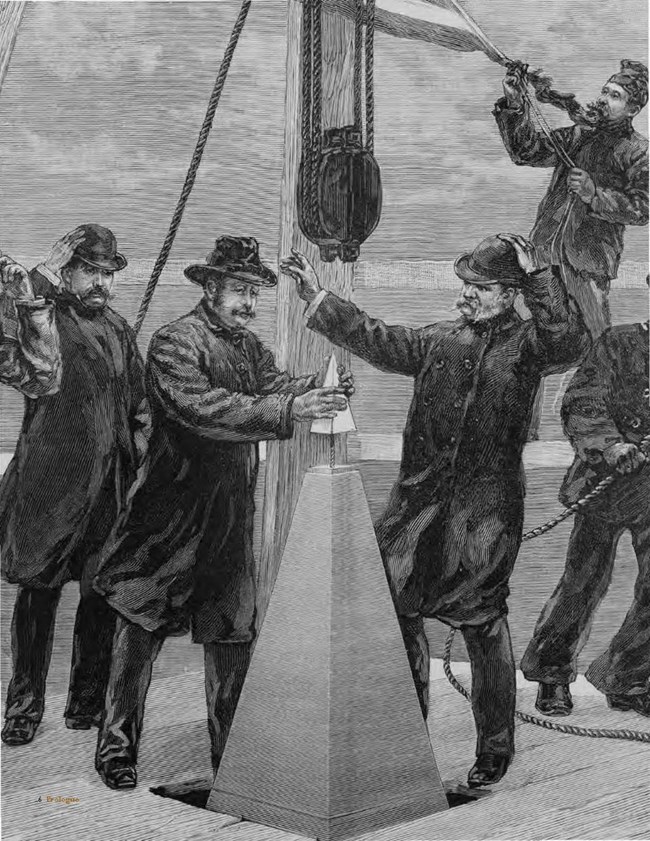Last updated: October 5, 2021
Article
The Point of the Matter

Aluminum is indeed one of the most common elements in the earth’s crust, after silicon and oxygen, but it does not naturally occur in metallic form and in the late 19th century was difficult to process. Its most important ore is bauxite, named after the French castle Les Baux, in Provence, where it was first discovered.
In 1807, British scientist Sir Humphrey Davy was the first to suggest that the compound alumina, named after its presence in alum, contained a metal element. He was correct, for alumina is aluminum oxide, or Al2O3. He also came up with a name for the new metal, aluminum.
Further discoveries improved the purification process and lowered the price, but even by 1884, the year of the Washington Monument’s completion under Lt. Col. Thomas Lincoln Casey, aluminum was still $1.10 an ounce, the same as the then- prevailing market price of silver, which was considered a precious metal. The U.S. government wanted to have a precious metal cap for the monument, so it chose aluminum, and hired William Frishmuth of Philadelphia for the job.
Frishmuth was a German chemist who had emigrated to the United States. He had spent some 28 years and $53,000 experimenting with the refinement of aluminum. The process he hit upon was to heat the ore until the alumina vaporized, and then add sodium vapor.
Sometime in November 1884 Frishmuth successfully cast an aluminum tip. It was the largest piece of aluminum cast up until that time, at 8 inches tall. He charged $225.00 for it.
Before sending it on to Washington, however, Frishmuth put the tip on display at Tiffany’s jewelry store in New York City---without permission. A flurry of messages followed from this.
On November 25, Frishmuth sent a telegram to Captain George Davis, Casey’s assistant, by Western Union: “See todays[sic] New York Times about apex which is on exhibition in Tiffanys[sic] Jewelry store New York also get all New York papers tomorrow.”
Some stern, and quick, messages from Washington must have persuaded Frishmuth to send the tip without further delay, however, for on November 28 he telegraphed to Davis: “Apex will be your office tomorrow see todays[sic] Phila Press.”
The next day, Frishmuth, telegraphed Casey himself: Thanks if you can please exhibit in the Capital[sic] Senate + Congress Monday.” This did not happen.
The aluminum tip was finally put into place during a ceremony on December 6, 1884. As for Mr. Frishmuth, he still had some aluminum left over, so he advertised in the February 28, 1885 Scientific American for customers who wanted an aluminum watch charm at 75 cents, an aluminum alloy charm for 30 cents, and the alloy charm with gilding, also at 30 cents.
As it later turned out, the Washington Monument tip was not quite pure. An undated Record Group 42 letter from an unnamed scientist found the tip to be 97.75% aluminum, 1.70% iron, and the remaining 0.55% silicon.
Ironically, after all this, on February 23, 1886, less than two years after the Washington Monument’s completion, a recent graduate from Oberlin College, Ohio, by the name of Charles Martin Hall, discovered the process for making aluminum cheap and commonplace.
He dissolved alumina in molten cryolite, and ran electricity through the mixture for two hours. Unlike some inventors, Hall proved to be good at business as well. Sometime in 1888 he came to Pittsburgh, and helped found the Pittsburgh Reduction Company. In December of that year, the company opened for business. Hall eventually made a fortune of $27,000,000.
Coincidentally, a young Frenchman named Paul Heroult, was working on the same process, and succeeded with it just two months after Hall.
As for the monument tip, it has been in place ever since. It did nearly disappear in July 1941, when it was volunteered for the nationwide aluminum scrap drive. Collecting used aluminum for civilian recycling would free up virgin aluminum for military uses such as airplanes. Fortunately, the proposal was quietly dropped.
Today the tip is still in good shape. On sunny days it can sometimes even be seen from the ground, glowing like a small, white point.
